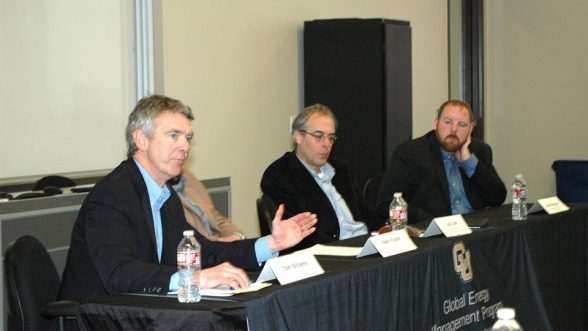
Global Energy Management hosts robust discussions that drill into one of state’s key industries
DENVER – Water recycling remains relatively uncommon in oil fields — less than 10 percent of water used in hydraulic fracturing is recycled — but the practice is gaining momentum as technology and infrastructure evolves.
A wide range of energy experts from the academic, business and government worlds met for a robust three-hour discussion about the water-energy nexus on Jan. 9 at the CU Denver Business School. More than 45 people attended the Global Energy Management program’s “Water and Ambient Energy on Oil & Gas Drilling and Production Sites: Framework for Business Decision-Making.”
“I wanted to create a situation where the program can become a working forum for entities that aren’t used to working with each other,” said GEM Director Jim Marchiori. He did just that with the event spanning three panels that covered everything from the big picture — the economics of water and energy — to site-specific issues, such as factors hindering ambient energy and water reuse in the oil fields.
GEM faculty experts were joined by representatives from the Colorado School of Mines, the National Renewable Energy Laboratory, and businesses including High Sierra, Ormat Technologies and TerraWatt Power Solutions.
High Sierra, in partnership with Noble Energy, is operating the first pipeline in Colorado, in Weld County, that sends recycled water from one of its treatment facilities back to drill sites for reuse in hydraulic fracturing, commonly called fracking. The practice is both helping to reduce roadway stress caused by trucks hauling water and creating economic efficiencies for energy producers.
“The goal of our company is to get ahead of the curve,” said Doran Oancia of High Sierra.
“I think there will be more efficient recovery of these resources going forward,” said Tzahi Cath, associate professor of civil and environmental engineering at the School of Mines. “The question is the economics of recovering these materials. It’s not simple.”
Janie Chermak, a GEM lecturer and professor of economics at the University of New Mexico, said that, based on water volumes pumped at drill sites in Texas, 166 gallons of water per person per day are used in energy production in the United States. “It’s important that we look at this as an integrated system and as integrated industries rather than in silos, as we have in the past,” she said.
John Chahbandour, director of strategic water management for MWH Global, said water is a shared resource that must be managed as such. Regardless of whether a person’s perspective is energy independence or supplying water to farmlands, “the fundamental aspect of economic development in our society is being able to use water in a responsible way that optimizes economic, social and environmental benefits.”
Marchiori said the cross-discipline format of the panels, and the conversational approach they took with the audience, contributed to spirited discussions. “They’re going to come up with ideas and solutions that they’re not going to come up with sitting in their own silos,” he said. “I think that’s part of our role as an academic institution — to drive that. Because if we don’t, who will?”


